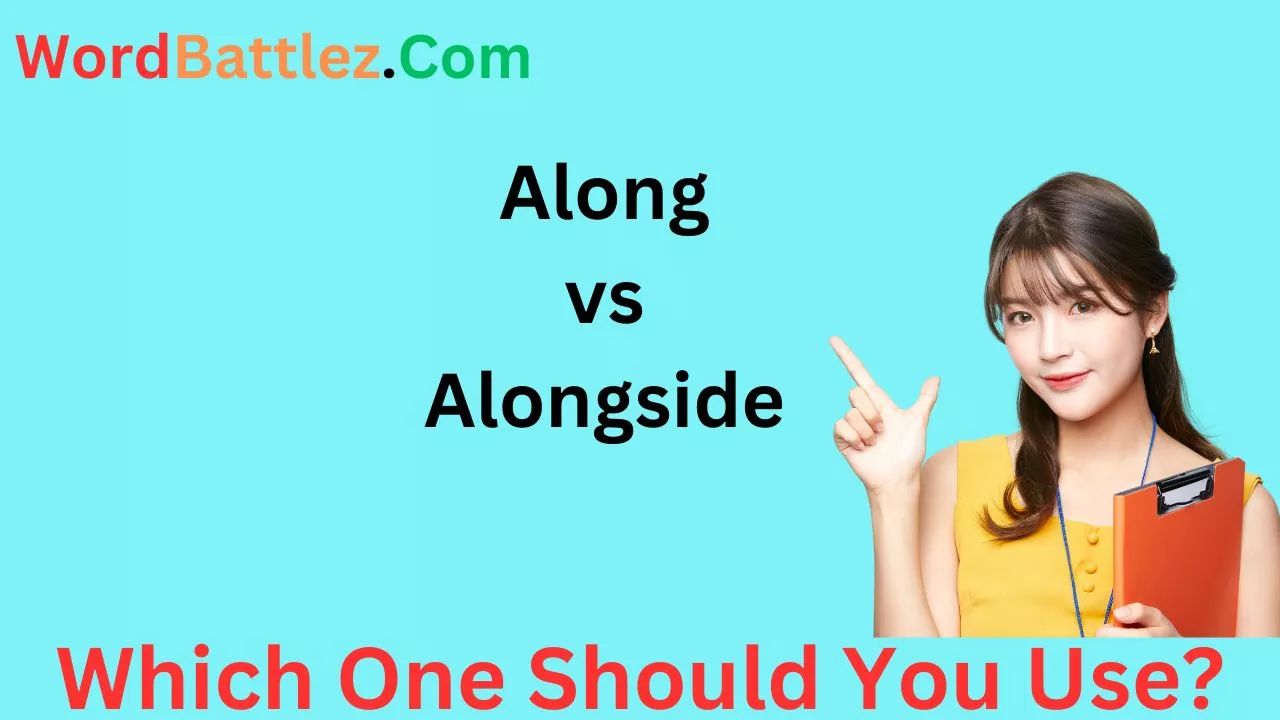In the English language, subtle distinctions between similar words can often lead to confusion. One such pair is “along” and “alongside.”
While they may appear synonymous at first glance, each word has its own unique usage and context.
In this article, we will dissect the differences between “along” and “alongside,” provide practical examples, and guide you on how to use each term correctly in your writing and speech.
Definition and Usage
Let’s start by defining both “along” and “alongside” and exploring how and when to use each word.
What Does “Along” Mean?
“Along” is a preposition and adverb that denotes movement in a line or direction, typically parallel to something. It often indicates accompaniment or progress in a specified direction.
Definition:
- In a line or direction: Refers to movement or position alongside something.
- In company with: Can indicate accompaniment.
Examples:
- ✅ “We walked along the beach at sunset.”
- ✅ “She placed the flowers along the table.”
- ✅ “They traveled along the riverbank.”
What Does “Alongside” Mean?
“Alongside” is primarily used as a preposition, meaning next to or beside something. It implies a close proximity or parallel position.
Definition:
- Next to or beside: Indicates physical closeness or alignment with something.
- In addition to: Can suggest cooperation or partnership.
Examples:
- ✅ “The boat was docked alongside the pier.”
- ✅ “He worked alongside his colleagues on the project.”
- ✅ “The car parked alongside the curb.”
Side-by-Side Comparison
To further clarify the differences, here’s a side-by-side comparison of “along” and “alongside” with examples:
| Correct (Along) | Correct (Alongside) |
| ✅ “We walked along the path.” | ✅ “The dog ran alongside its owner.” |
| ✅ “She hung the paintings along the wall.” | ✅ “He stood alongside his friends.” |
| ✅ “The river flows along the valley.” | ✅ “The runners jogged alongside each other.” |
| ✅ “They traveled along the coast.” | ✅ “She placed the chairs alongside the table.” |
| ✅ “He read the book along with his studies.” | ✅ “They collaborated alongside other teams.” |
In summary, “along” often refers to a journey or movement, while “alongside” emphasizes a position of closeness or partnership.
When to Use “Along“
You should use “along” when referring to movement in a linear direction, whether that’s physically or metaphorically. Here are some examples:
Physical Movement:
- ✅ “We walked along the river during our hike.”
Accompaniment:
- ✅ “She carried her groceries along the way.”
Progress:
- ✅ “He made progress along his career path.”
In these instances, “along” effectively conveys the sense of direction, movement, or accompaniment.
Why You Should Avoid “Alongside” in This Context
Using “alongside” in contexts that require “along” can lead to confusion, as “alongside” implies a fixed position rather than movement or direction.
Common Mistake Example:
- ❌ “They walked alongside the trail.”
Correction:
- ✅ “They walked along the trail.”
In this case, “along” is more appropriate because it describes the action of moving.
When to Use “Alongside”
“Alongside” is appropriate when you want to convey the idea of being next to something or someone, either literally or figuratively. Here are some examples:
Physical Proximity:
- ✅ “The new school was built alongside the park.”
Collaboration:
- ✅ “The organization worked alongside local volunteers to improve the community.”
Comparison:
- ✅ “He felt proud to stand alongside his fellow graduates.”
In these contexts, “alongside” emphasizes closeness and cooperation.
Why You Should Avoid “Along” in This Context
Using “along” in situations that require “alongside” can create ambiguity, as it lacks the emphasis on proximity.
Common Mistake Example:
- ❌ “The car was parked along the building.”
Correction:
- ✅ “The car was parked alongside the building.”
In this example, “alongside” makes it clear that the car is right next to the building.
Everyday Usage Examples
To help solidify your understanding, here are practical examples of “along” and “alongside” in everyday conversation:
Along Examples:
- ✅ “They strolled along the shoreline.”
- ✅ “I found the keys along the counter.”
- ✅ “The children ran along the path in the park.”
- ✅ “He placed his coffee along the edge of the table.”
- ✅ “The train travels along the tracks.”
Alongside Examples:
- ✅ “She stood alongside her partner during the ceremony.”
- ✅ “The sculpture was installed alongside the fountain.”
- ✅ “They worked alongside experts to complete the project.”
- ✅ “The exhibit was displayed alongside other local artists.”
- ✅ “He sat alongside her during the meeting.”
Conclusion
Understanding the difference between “along” and “alongside” is essential for clear and effective communication. While “along” indicates movement in a linear direction, “alongside” emphasizes proximity and partnership.
By using these words correctly, you can enhance your writing and speech, avoiding common grammar mistakes.
Whether you’re walking “along” a path or standing “alongside” a friend, choosing the right word will make your meaning clear and precise.
Keep these tips in mind, and you’ll navigate the nuances of English with confidence!
Meta Description:
Explore the difference between ‘along’ and ‘alongside’ with clear definitions, practical examples, and tips for everyday usage. Learn how to use each term correctly in your writing!

















